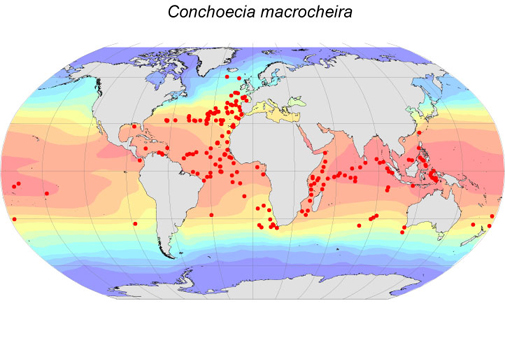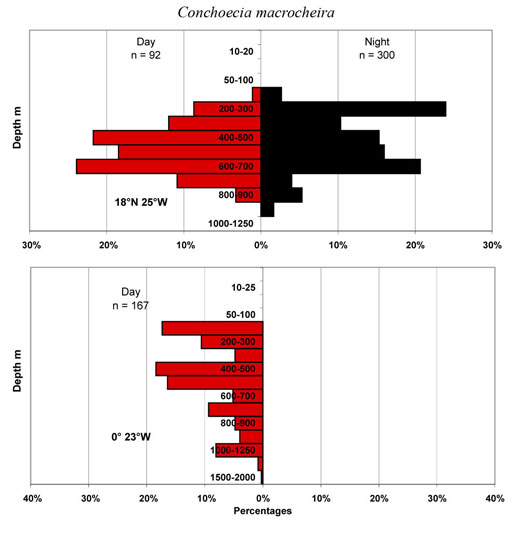Atlas of Atlantic Ostracods
Taxon details
Conchoecia macrocheira Müller, G.W., 1906
- Order:
- MYODOCOPA
- Suborder:
- Halocypridina
- Family:
- Halocyprididae
- Subfamily:
- Conchoecinae
- Size range (females):
- 3.4-3.6 mm
- Size range (males):
- 3.0-3.2 mm
- Depth:
- meso-/bathypelagic
Notes
316 records
This is the largest species in Müller’s “magna group”, which Poulsen (1973) retained in the genus Conchoecia. It is never abundant but turns up regularly in mesopelagic samples from between 200-800m, but both adults and juveniles occur at bathypelagic depths. Geographically it ranges from 50°N to 38°S. The two records from 60°N in the North Atlantic are from Vavra (1906), who described his specimens as a novel species hamata, but many of his identifications are more than a little suspect. This species shares with Pseudoconchoecia concentrica the distinction of having juveniles instars that are sufficiently distinctive to have been described as separate species. In this case Fowler (1909) described the juvenile instars, with their distinctively domed rostra, as Conchoecia zetesios. It was Skogsberg (1920) who pointed out this particular error. It means that the very early stage juveniles instars of this species can be identified with confidence.
| All | n | Mean mm | s.d. | Range mm |
|---|---|---|---|---|
| Female | 100 | 3.48 | 0.122 | 3.24-3.84 |
| Male | 75 | 3.02 | 0.072 | 2.84-3.20 |
| A-1 | 36 | 1.52 | 1.217 | 2.40-2.60 |
| A-2 | 32 | 1.72 | 0.050 | 1.62-1.86 |
| A-3 | 32 | 1.17 | 0.042 | 1.10-1.32 |
| A-4 | 18 | 0.83 | 0.015 | 0.80-0.86 |
| A-5 | 9 | 0.59 | 0.033 | 0.54-0.64 |





